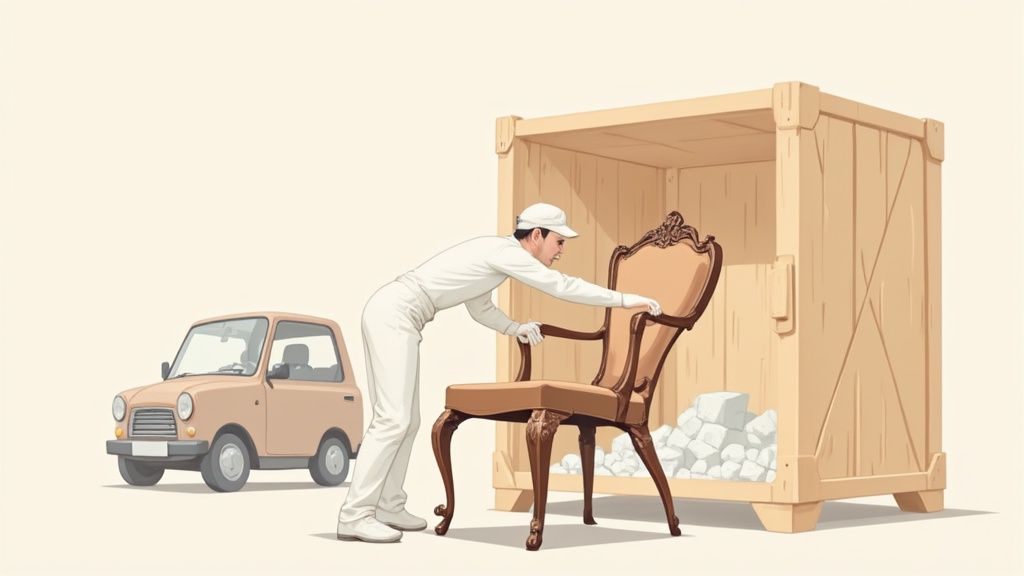When it comes to shipping antique furniture, what you do before you even touch the bubble wrap is what truly matters. I've seen it time and time again: the success of a move hinges on careful preparation, not just on packing prowess. Your first and most crucial job is to thoroughly document your item's current state and get a formal appraisal. These steps are your safety net—they're non-negotiable for insurance purposes and are your best defense against headaches later on.
Your Pre-Shipping Preparation Guide
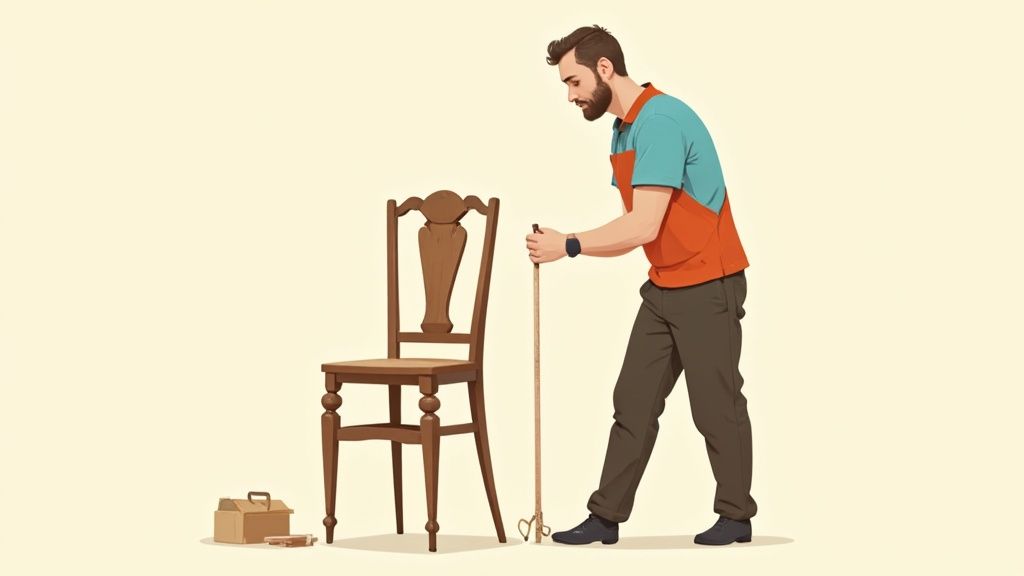
Think of this initial stage as building a fortress of proof around your valuable piece. Every photo you take and every note you make directly impacts the safety of your furniture and, just as importantly, your ability to file a successful claim if the unthinkable happens. This isn't just about wrapping a chair in a blanket; it's about creating an indisputable record of its value and condition before it ever leaves your possession.
This process is so critical because shipping antiques isn't like moving regular household goods. It's a highly specialized corner of the logistics world, built entirely around protecting fragile, often irreplaceable, high-value items. The market for moving these treasures long-distance is actually projected to grow significantly through 2033, driven by collectors relocating and a boom in international sales. You can dig into more data on this antique moving trend to see just how specialized this field has become.
To make sure you've covered all your bases, I've put together a quick checklist. Running through these tasks will give you peace of mind and a solid foundation for a successful shipment.
Antique Furniture Pre-Shipping Checklist
| Task | Why It's Important | Pro Tip |
|---|---|---|
| Comprehensive Photos | Creates a clear "before" picture for insurance. | Use good, natural light. Take close-ups of details and any existing flaws. |
| Walk-Around Video | Provides dynamic, 360-degree proof of condition. | Narrate the video, pointing out key features and any pre-existing wear. |
| Written Condition Report | Complements visuals with specific, detailed descriptions. | Be brutally honest. Note every single scratch, scuff, or imperfection. |
| Formal Appraisal | Establishes the item's true monetary value for insurance. | Find a certified appraiser who specializes in your type of antique. |
This checklist isn't just busywork; it's the bedrock of a secure shipping process. Let’s break down exactly what you need to do for each step.
Document Everything: The Condition Report
Your smartphone is your best friend here. The goal is to create a complete visual and written history of your piece before it gets handed off. This documentation is your key evidence in any potential insurance claim or dispute.
Take Detailed Photographs: Get shots from every conceivable angle. Make sure the lighting is bright and clear. You'll want wide shots of the entire piece, but don't forget the close-ups. Zoom in on carvings, joints, drawer pulls, and especially any existing imperfections like scratches, dings, or areas of discoloration.
Shoot a Walk-Around Video: A quick video can show things static photos can't. A slow, steady walk-around gives a much better sense of the item's overall condition and structure.
Write It All Down: This is your "condition report." Be painfully specific. Don't just write "scratch on top." Instead, describe it like this: "3-inch hairline scratch on the front-left corner of the tabletop." The more detail, the better.
I can't stress this enough: place a coin or a small ruler next to any existing damage in your photos. This provides an undeniable sense of scale, which is invaluable if a new, larger mark suddenly appears after transit. It removes all ambiguity.
Get a Formal Appraisal
Here’s a hard truth: a shipping company’s standard liability coverage won't come close to covering the true value of a genuine antique. An appraisal isn't just for your personal records; it's absolutely essential for securing proper insurance.
A professional appraisal from a certified expert provides a formal, defensible valuation of your item's market worth. This is the exact number you'll need to insure the piece for. Without that official document, you’re flying blind and leaving yourself dangerously under-protected.
How to Choose the Right Antique Shipper
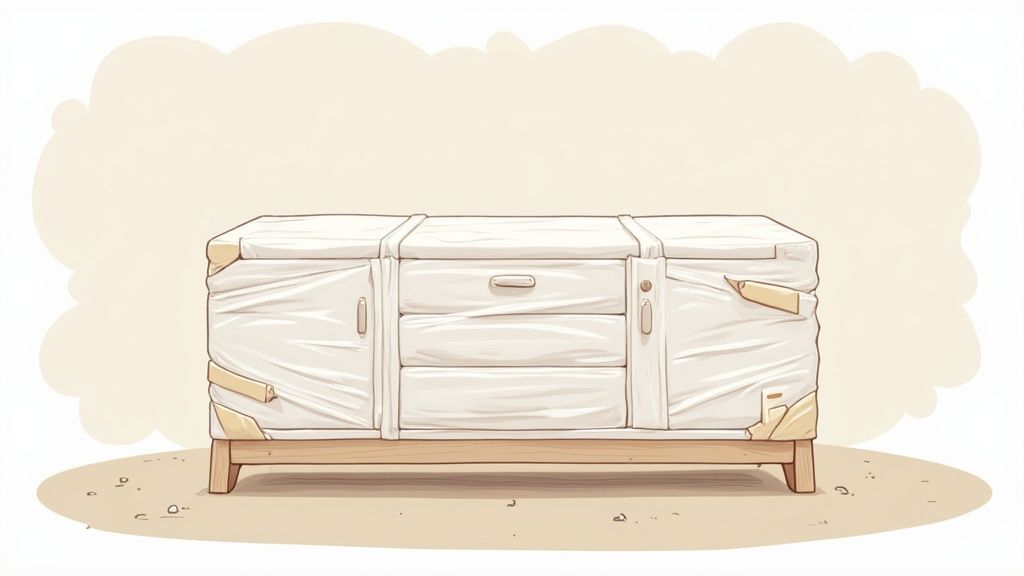
Handing over a treasured heirloom to a stranger is, without a doubt, the most stressful part of this whole ordeal. Your decision here isn't just about finding the cheapest quote. It's about finding a true partner who understands they’re not just moving a chair—they’re handling a piece of history.
The best shippers get it. They see both the financial and the sentimental value wrapped up in what they’re transporting. Making the right choice comes down to knowing what to ask and how to spot a genuine specialist. Honestly, this is the one decision that will determine whether your antique arrives safely or becomes a cautionary tale.
Specialized Movers vs. General Freight
Once you start searching for quotes, you'll run into a couple of different types of companies. It's absolutely critical to know the difference. The standard freight carrier that ships pallets of boxed goods simply doesn't have the finesse needed for a delicate, 18th-century writing desk.
General Freight: These are the big, common carriers and often the most budget-friendly. The problem? Their entire system is built for volume and speed, relying on automated conveyors and forklifts. Their staff isn't trained for fragile, oddly shaped items, making the risk of damage sky-high.
White-Glove Services: Think of this as the premium, hands-on option. These movers do it all, from professional packing and building custom crates to inside delivery and even setup in the room of your choice. They're trained for high-value items and are a much, much safer bet.
Dedicated Antique Shippers: These are the masters of the craft. They blend the careful handling of white-glove services with an expert-level knowledge of antiques. We're talking climate-controlled trucks and firsthand experience with the unique quirks of different furniture periods and styles.
For any piece you truly care about, a dedicated antique shipper is the only way to go. You simply can't put a price on their expertise in protecting delicate finishes, intricate carvings, and aged wood.
I’ll never forget a story a friend told me. He tried to save a few hundred dollars by shipping a gorgeous Georgian mahogany sideboard with a standard freight company. It showed up with a massive gouge down the side and a snapped leg. Those "savings" vanished in an instant, and the battle to get a tiny insurance payout was an absolute nightmare. That's the real cost of picking the wrong shipper.
Key Questions to Vet Potential Shippers
Before you even think about signing a contract, you need to interview any potential carrier. Their answers (or lack thereof) will tell you everything you need to know about their competence and level of care. Treat it like a job interview, and come prepared with these questions.
Do you have experience with this specific type of furniture? Don't just ask if they've moved antiques. Get specific. Ask if they’ve handled pieces from a similar era or a comparable style. A shipper who understands the fragility of veneer is invaluable. Knowing a bit about how to identify antique furniture yourself will also help you have a more detailed conversation.
What are your specific packing and crating methods? A real pro won't hesitate. They should be able to walk you through their entire process, detailing the materials they use (like furniture blankets, foam-in-place, and acid-free paper) and explaining why they’d recommend a soft wrap versus a full custom crate for your specific piece.
Do you offer climate-controlled transport? This is a big one. Drastic changes in temperature and humidity can make old wood crack, warp, and split. If your piece is traveling a long distance, especially through different climate zones, climate control is non-negotiable.
Can you provide proof of insurance and your credentials? Any legitimate mover will have this ready. Ask for their Department of Transportation (DOT) number and a certificate of insurance. Then, look closely at that policy. You need to confirm it covers the full appraised value of your antique, not just a standard, per-pound rate that wouldn't even cover the cost of a broken leg.
Packing and Crating Your Antiques Like a Pro
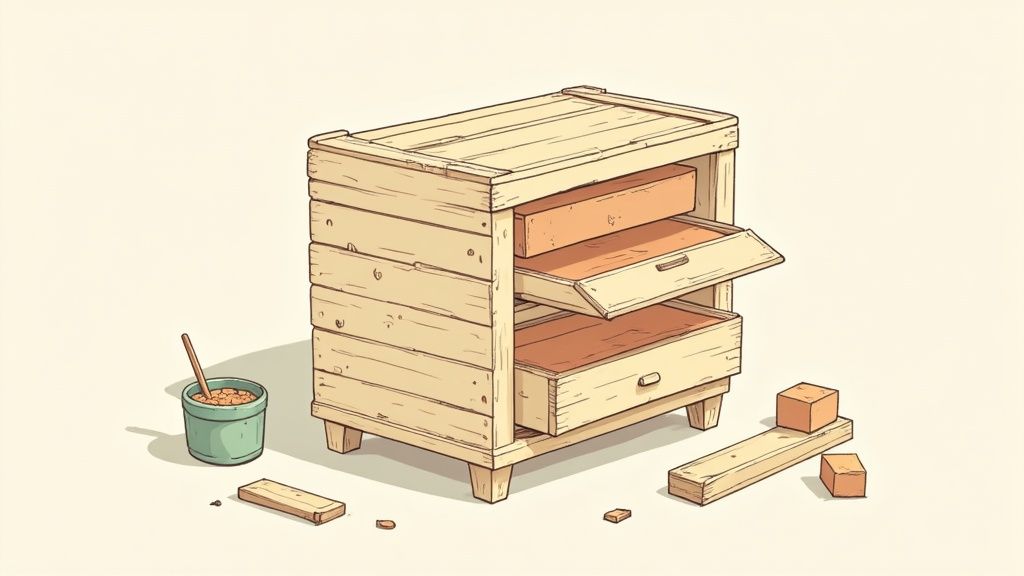
This is where the rubber meets the road. All the planning in the world won’t matter if your furniture isn't packed correctly. A proper packing job is its only real defense against the bumps, drops, and vibrations that are just a part of shipping. You have direct control over this step, and a little bit of know-how can make all the difference between a successful delivery and a heartbreaking phone call.
The demand for these beautiful old pieces is stronger than ever. The global second-hand furniture market was valued at over $37 billion in 2024 and is expected to explode to nearly $100 billion by 2037. This shows a huge shift towards owning items with history and character. You can learn more about furniture market trends to see just how big this market has become.
Choosing the Right Packing Materials
The materials you choose are every bit as crucial as your technique. I've seen people use the wrong supplies and cause more damage than the journey itself—think moisture rings from trapped condensation or fine scratches from cheap paper.
Here’s what should be in your arsenal:
- Furniture Blankets: These are non-negotiable. They are your piece's main shield, providing thick, soft cushioning that prevents nicks and dings.
- Acid-Free Paper: For any surface with a delicate finish, paint, or veneer, this is essential. Standard paper has acids that can literally eat into the finish over time.
- Bubble Wrap & Foam Sheets: Perfect for giving extra padding to vulnerable spots like legs, corners, and carvings. But remember, never let plastic bubble wrap touch a finished wood surface directly. Always lay down a blanket or acid-free paper first.
- Cardboard Corner Protectors: For any case piece—desks, chests, dressers—these are a must. Corners are magnets for impact, and these little guards absorb the shock.
Critical Tip: Whatever you do, avoid using standard plastic shrink wrap directly on finished wood. It’s a recipe for disaster. It traps moisture right against the surface, which can cloud a finish, cause veneer to bubble up, or even kickstart mold growth if the piece travels through different climate zones.
The Art of Securing Your Furniture
Once you have your supplies, it's time to wrap. Every piece of furniture has its own quirks—a wobbly leg, a swinging door, a delicate carving. Your job is to make it a single, solid, unmoving block.
Start by taking off anything you can: knobs, shelves, finials, or mirror supports. Wrap each one separately and label it clearly so you know exactly where it goes later. For doors and drawers, resist the urge to use tape directly on the wood; it will pull the finish right off. The right way is to wrap the entire piece snugly in furniture blankets, then use stretch wrap over the blankets to hold everything shut.
If you spot a minor problem like a loose joint while prepping, now is the time to fix it. A small weakness can become a major break during transit. For easy DIY fixes, you can check out our guide on basic antique restoration tips.
To Crate or Not to Crate?
This is the final big packing decision: does your piece need a custom crate, or is a professional "soft wrap" enough? The answer depends entirely on the item’s value, fragility, and how it’s being shipped.
| Packing Method | Best For... | Key Benefits |
|---|---|---|
| Soft Wrapping | Sturdy pieces (like an oak commode) being shipped by a specialized white-glove mover. | Less expensive, quicker to pack. |
| Custom Crating | Highly valuable, fragile, or odd-shaped items (think grandfather clocks, marble-topped tables, or chairs with delicate legs). | The ultimate protection against impact and stacking pressure. It's a must for freight shipping. |
Think about the difference between shipping a solid oak chest and a delicate, veneer-inlaid side table. The chest is a beast; it could likely handle a trip with just a high-quality soft wrap. But that veneer table, with its fragile surface and spindly legs, absolutely demands the rigid, unyielding protection of a custom crate to guarantee it arrives safely.
Navigating Insurance and International Shipping Rules
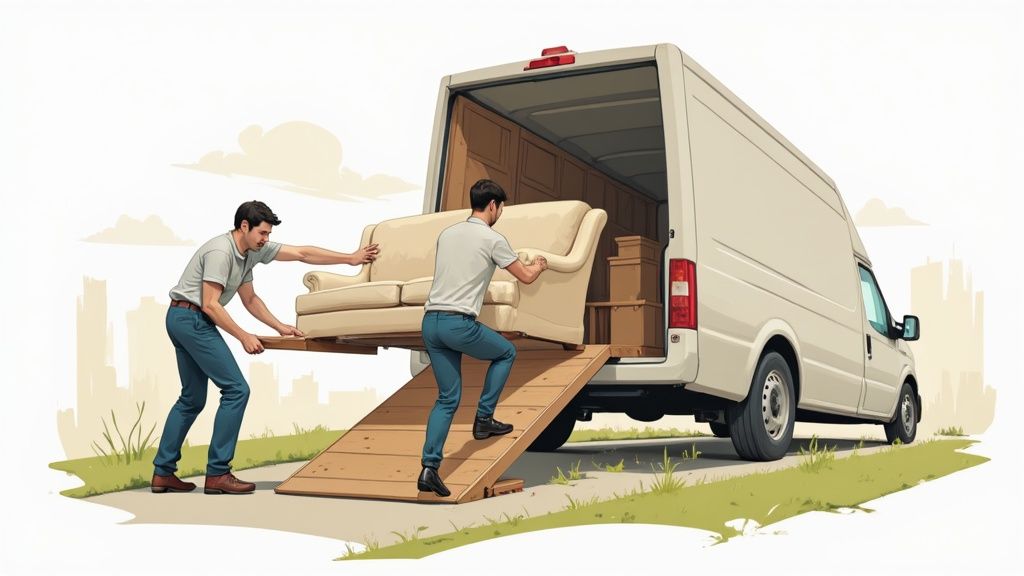
Sending a valuable piece of furniture across the country, let alone across an ocean, involves more than just bubble wrap and a sturdy box. You have to get the insurance and regulations right. From my experience, these two areas are precisely where people run into expensive, frustrating problems that can turn a simple shipment into a complete mess.
Let's get one thing straight right away: a shipper’s standard liability is not insurance. This is a common and costly mistake. Most carriers offer a basic liability that's calculated by weight—often a paltry $0.60 per pound. Think about that. If your 100-pound antique table is worth thousands, you'd only get back $60. That's why you absolutely must get a separate, dedicated insurance policy that covers the full appraised value of your piece.
I always tell people to read the fine print on any insurance policy. Look specifically for exclusions related to "insufficient packing" or "inherent vice" (pre-existing flaws). If you packed the item yourself, some policies may not cover it. Your pre-shipping documentation is your best defense here.
Securing Comprehensive Insurance Coverage
When you're looking at policies, either through your shipper or a third-party insurer, there are a few non-negotiables. You should always insist on an "all-risk" policy. It offers the broadest protection against all sorts of potential damage or loss while your furniture is in transit.
Here’s a quick checklist of what to confirm:
- Coverage for Full Appraised Value: The policy must cover the amount from your formal appraisal, not some lower, arbitrary "declared value."
- Repair and Restoration Costs: A good policy doesn’t just cover total loss. It should also cover the cost of getting a professional to restore the piece if it sustains repairable damage.
- Door-to-Door Coverage: Make sure the insurance is active from the second it leaves your possession until it’s safely inside its final destination.
Handling International Customs and Duties
Shipping antique furniture overseas throws customs, tariffs, and import rules into the mix. It can seem daunting, but it's entirely manageable if you're prepared. How complex it gets really depends on where you're sending it.
The United States, for instance, is a massive furniture importer, accounting for around 25% of the world's total imports. You can read more about the scale of the global furniture trade on GlobeNewswire. This high volume means US Customs has well-defined procedures, but it also means they're incredibly thorough.
You’ll need a stack of paperwork. The most common documents are:
- Commercial Invoice: Details who is sending it, who is receiving it, what it is, and what it's worth.
- Bill of Lading: This is your contract with the shipping company.
- Customs Declaration Form: This gives customs officials the specific details about the item you're importing.
The good news is that many countries, the U.S. included, often allow duty-free entry for antiques that are over 100 years old. However, the burden of proof is on you—your appraisal documents are essential here. My best advice? Always work with a shipper who has real experience in international moves. They'll handle the complex paperwork and make sure your antique has a smooth journey through customs.
Inspecting Your Antique Furniture After Delivery
The long journey is almost over. Your piece has arrived, but the job isn't done until it's safely inside and you've confirmed its condition. It's easy to get excited and rush this final step, but these last few moments are just as critical as the packing. Moving too quickly now can lead to accidental damage or, even worse, jeopardize your chances of a successful insurance claim.
The first thing to do is manage the unwrapping. If you paid for a white-glove service, their crew will handle the heavy lifting, but you absolutely need to be there to supervise. If you're uncrating it yourself, take your time. Work methodically. Use a pry bar gently to open the crate, but never, ever use the furniture itself for leverage.
Once it's open, carefully slice away the blankets, bubble wrap, and foam. I can't stress this enough: be extremely careful with any blade you use. Keep it well away from the wood surface to prevent an accidental slip from turning into a nasty scratch.
The Post-Delivery Inspection Checklist
With the piece finally unwrapped, it's time for the moment of truth. Grab the photos and the detailed condition report you made before it was shipped. This is where you meticulously compare the "before" with the "after."
Go over the furniture inch by inch. You're looking for anything that wasn't there before.
- Surface Damage: Are there any new scratches, scuffs, or chips in the wood, veneer, or paint?
- Structural Integrity: Gently test the legs and joints. Does anything feel wobbly or looser than you remember?
- Hardware and Components: Do the drawers still slide smoothly? Do the doors hang straight? Is all the original hardware still there and secure?
- Finish Condition: Look closely at the finish. Do you see any new watermarks, cloudiness, or discoloration?
A little pro tip: always do your inspection in bright, natural light. Your phone's flashlight is also your best friend here, perfect for getting a good look at dark corners and the underside of the piece where damage loves to hide.
What to Do If You Find Damage
Finding new damage is incredibly frustrating, I know. But how you react in the next few minutes is crucial.
If the delivery team is still there, point out the damage to them immediately. More importantly, make a detailed note of it on the Bill of Lading (BOL) before you sign a single thing. The BOL is the official delivery receipt, and noting the damage on it is your single most powerful piece of evidence.
Next, get your camera out again. Document the new damage with the same level of detail you did before shipping—clear, well-lit photos and even a short video. Then, without delay, contact both the shipping company and your insurance provider to formally start the claims process. This is where having a clear record of the item's pre-shipment condition and its official value becomes absolutely essential. If you need a refresher, our guide on how to find the value of antiques can be a huge help here.
Answering Your Top Questions About Shipping Antiques
Even with the best-laid plans, shipping a piece of antique furniture can feel like a leap of faith. It's perfectly normal to have a few lingering questions, especially when you're responsible for something so valuable and often irreplaceable. Let's tackle some of the most common concerns I hear from collectors and sellers.
Getting these details sorted out beforehand will give you the confidence to see the shipment through without any last-minute surprises.
How Much Should I Expect to Pay for Shipping?
This is usually the first question on everyone's mind, and the honest answer is: it varies. A lot. There's no flat rate for shipping antiques because every piece and every journey is unique.
Think of it this way: shipping a small, robust oak side table a couple hundred miles might run you a few hundred dollars with a standard LTL (less-than-truckload) carrier. But if you're shipping a fragile, 18th-century French armoire from coast to coast, you're looking at a specialized white-glove service that could easily cost $1,500 or more.
Several key factors determine your final bill:
- Size and Weight: This is the most straightforward factor. Bigger and heavier simply costs more.
- Value and Fragility: A high-value item needs more insurance coverage. A delicate piece might need a custom-built crate, which adds to the cost.
- Distance: The mileage between pickup and delivery is a major price driver, especially for cross-country or international shipments.
- Type of Service: Do you just need curbside delivery, or do you need a team to carry it inside, unpack it, and place it? White-glove service is the premium option for a reason.
The only way to get a firm number is to request quotes. Reach out to at least three different companies that specialize in antiques. Be ready with photos, precise measurements, weight, and the item's appraised value to get a truly accurate estimate.
What's the Safest Shipping Method for a Large Antique?
When you're dealing with something substantial, like a grandfather clock or a dining set, there's one clear winner for safety: a white-glove moving service. I recommend them to clients constantly because they are, without a doubt, the gold standard for high-value items.
These aren't just movers; they're specialists. Their service typically includes professional packing on-site, building custom crates for delicate parts, transport in climate-controlled vehicles, and careful placement inside your home. They'll even handle the tricky disassembly and reassembly that many older pieces require.
Yes, this level of care costs more than basic freight shipping. But you're not just paying for transport; you're investing in peace of mind. The reduction in risk for an irreplaceable piece makes it a smart and necessary expense. Just be sure to double-check that their insurance policy covers the full appraised value of your item before you sign anything.
Is It Okay to Use a Regular Carrier like FedEx or UPS?
I get this question all the time, and my advice is almost always a firm no—unless the item is incredibly small and sturdy. We're talking about something like a small, solid wood jewelry box that can be wrapped and padded to the point of being bulletproof.
Parcel carriers like FedEx and UPS are masters of logistics, but their entire system is built around automated sorting, conveyor belts, and high-speed handling. That's a terrible environment for a one-of-a-kind antique. The risk of your package being dropped, crushed, or tossed is just too high.
Beyond the rough handling, their standard liability coverage is typically capped at a very low amount, which won't come close to covering the value of a genuine antique. For anything larger or more fragile than a shoebox, a specialized furniture shipper is the only truly safe choice.
Ready to uncover the history and value of your own treasures? With Curio, you can instantly identify antiques with just a photo. Download the app and let your collection tell its story. Learn more and get started at https://www.curio.app.
